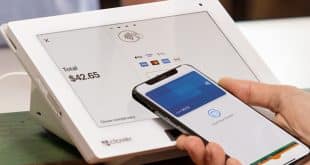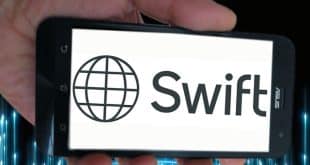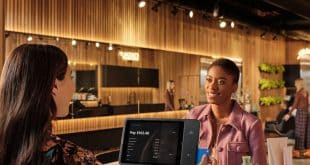Mobile POS devices may not displace entirely the traditional countertop POS terminal, but they could come close.
It emerged six years ago among the smallest of merchants and had only one function: accepting credit and debit card transactions. But now the mobile point-of-sale device and its attendant software have grown up.
The device has long since evolved into the tablet form factor from its smart-phone origins, and has acquired sophisticated software that can help merchants run their businesses without the hassle of having to keep a computer updated.
And now mobile POS (mPOS) devices and software are becoming a major market for payments companies, including independent sales organizations, independent software vendors, and value-added resellers that sell directly to merchants.
How much potential is there with mPOS devices? An estimated 13 million, with 7 million alone in North America, are forecast to ship in 2015, says Aite Group LLC, a Boston-based advisory firm, in a report released in April called “The Rise of Mobile Point of Sale: From New Kid to Next Gen.” That represents no more than 5% of the total potential global market opportunity, Aite says.
‘Few And Far Between’
Aside from the revenue opportunity that lies in transaction processing, the mPOS form factor is attractive to the payments industry because the business-management component of the software tends to make merchants less likely to switch providers.
Such tools, impossible to replicate on standalone POS terminals and much too expensive for smaller merchants when sold as software to use on personal computers, enable merchants to know more about their sales, their employees’ performance, and their customers’ purchasing habits.
They can be used to create marketing and loyalty programs to entice new customers and make them repeat shoppers. To many providers, it’s not just the tablet or smart phone alone that make the service attractive to merchants. Some sort of cloud service with the device to host the data and an app market so merchants can customize the mPOS service to their specific needs also help make a potentially compelling case.
Yet realizing that potential is proving elusive. Mobile POS providers themselves still constitute a highly fragmented industry, almost six years after the debut of Square Inc. and its now iconic card reader for smart phones.
“The guys successfully selling mPOS right now are few and far between,” says Rick Oglseby, senior analyst at Centennial, Colo.-based Double Diamond Group LLC.
Most merchant acquirers are selling some sort of mPOS product, but they are not faring well because many ISOs and acquirers are organized as a “sales firm,” Oglesby says. “If you consider what the average ISO is and has been forever, it’s a sales firm,” Oglesby says. “They don’t develop products.” What ISOs and acquirers tend to sell is a universal product—payment-processing services.
While payment-acceptance needs may be universal, the business tools merchants need vary. Software that helps manage patient records, manage menus, generate coupons, and manage tips is not the same for each merchant, Oglesby says. “All these are different for so many different types of businesses.”
ISOs and acquirers have to zero in on merchants if they are selling services that help them run their businesses, he says. “They need to get to them at a time in the business lifecycle when it makes the most sense,” Oglesby says. For many, that means when the merchant opens its doors.
“Acquirers don’t understand merchant needs,” he says. “They don’t understand how to match the right products with the right merchants. That’s one of the biggest reasons that mPOS has been primarily successful in the smallest [merchant] space. It has the most simplistic needs.”
There is some evidence, however, that larger merchants are adopting mPOS devices.
“There is a move toward tablet POS, which is increasingly being picked up by larger businesses and specialty retailers,” says Andrew Copeman, the Aite analyst who wrote the mPOS report. “The key attraction of these devices is the ability to deploy a range of software apps that a company feels are relevant to its own particular strategy for engagement with customers.”
‘A Broken System’
The app strategy is central to many mPOS providers, whether they are software developers or payments companies.
“Apps changed everything,” says Peter Karpas, First Data Corp. senior vice president and global head of small-business products. Atlanta-based First Data sells the Clover POS system, a tablet-based service that has more than 100 apps in its store, many put there by third-party developers. “Now a merchant can do all sorts of things from that terminal they’ve never been able to do before.”
For example, the Time Clock app by Homebase for Clover has clock-in and clock-out functions for employees, cash-tip declaration, and shared schedules. The clock-in function also snaps an image—using the front-facing camera on the device—of the employee as he starts a shift, enabling employers to know if someone is punching in for another employee, Karpas says.
It’s that type of functionality that makes mPOS devices so appealing to merchants, especially if they can use off-the-shelf hardware, like an iPad or Android tablet. Square’s debut in 2009 was followed in 2010 by the advent of Apple Inc.’s iPad, establishing a new type of computing device that consumers and merchants have welcomed wholeheartedly.
“Part of it is the acceptance of new technology,” Norm Merritt, co-chief executive of ShopKeep.com Inc., a New York-based tablet-POS provider. “It really speaks to what historically has been a broken system.”
Merritt refers to Windows PCs that many merchants used, and continue to use, to run their POS software. Issues can arise because with multiple USB ports on computers, any USB-equipped device could be attached to the PC. That could introduce malware that might surreptitiously harvest sensitive payment data. It can also cause general issues, necessitating an expensive service call, he says.
The POS software may not receive frequent updates, or may require expensive service calls to update. That makes user-friendly devices and apps more appealing, Merritt says.
“We’re fixing something that’s broken,” he says. “Those who do adopt [mPOS] have a competitive advantage. They have the ability to do a better job at driving profitability for their businesses.”
A Different Take
Even a traditional POS-terminal maker like VeriFone Systems Inc. sees value in mPOS devices. San Jose, Calif.-based VeriFone launched the PayWare Mobile E355 device this year as a mobile POS device that accepts magnetic-stripe, near-field communication (NFC), EMV, and Apple Pay transactions.
The device supports multiple mobile operating systems, including Android, iOS, and Windows, and supports Wi-Fi, Bluetooth, and USB connectivity.
The decision on which device to use centers on the experience the merchant wants to provide consumers, says Hitesh Anand, VeriFone vice president of product, commerce enablement, and mobile. “If I go to a store, in the context of line busting, that’s an experience where mPOS will play a role,” Anand says.
But, a merchant may not need that and could be satisfied with a countertop POS terminal.
“I don’t see one eclipsing another,” Anand says. “It’s the experience that retailers want the consumers to have. The context of the experience will define the use of a countertop or mPOS device.”
Mobile POS providers have a different take.
Tablet POS systems are poised to dominate, says Chris Ciabarra, chief technology officer at San Francisco-based Revel Systems Inc., makers of an iPad-based POS system.
In fact, he declares, “the market is going to be 100% tablets within five years. If you don’t have a tablet, you’re not going to be able to compete.”
Last month, Revel Systems took the unusual step of opening a retail showroom and sales office in New York City. It also offers QuickBooks Online integration, and develops apps and hardware configurations designed specifically for frozen-yogurt shops, pizzerias, bars, and other merchant types.
This degree of sophistication is unheard-of with standalone POS terminals. And, when sold as PC-based POS systems, it’s priced out of many merchants’ budgets. But mPOS vendors say they deliver it in response to merchants’ thirst for more data that can help them run their business.
“They need to be able to track inventory, report their sales, capture customer data, and integrate into accounting and [enterprise-resource planning] systems,” says Matthew Inan, director of business development and sales operations at e-Nabler Corp., the Puerto Rico-based maker of eMobilePOS. “We learned a long time ago the POS cannot be an island. Integration is important because it saves [merchants] bookkeeping time and improves accuracy.”
Merchants are getting smarter at knowing what they want from mPOS services, he says. “We see companies put a bit of a brake on their deployments to better understand their own business requirements and then look for a system mature enough to service their requirements. They’re being more selective. They’re looking for integrated systems.”
Also, they want operating systems to be from the same company; if using Windows, they want Windows tablets, Inan says.
‘Waking up’
The greater availability and use of so-called cloud-based services aids mPOS adoption. Cloud-based technology stores data on servers hosted via the Internet instead of locally on a device.
“We see the cloud as being fundamental to how small and mid-size businesses will compete in the marketplace,” says Mike English, vice president of product development at Heartland Payment Systems Inc., a Princeton, N.J.-based payment processor. “When you look at the cloud service, customer payments and market-basket analysis are key to helping them understand where they are. It gives them a perspective they haven’t necessarily had.”
He, too, suggests that mobile devices will eclipse the countertop terminal attached to a PC.
“The terminal manufacturers are waking up to this,” English says. “In terms of Heartland, we see not only mobile being very important to the future of our company and our customers, but the cloud services as well. We see that growing significantly.”
Indeed, the spread of mPOS will contribute to continuing electronic payment card use, suggests Aite’s Copeman. “There is a lot of talk about the mobile phone’s potential to transform payments and replace the plastic card,” he notes in his report, “but mPOS has made huge strides while mobile-payment developers still struggle to gain meaningful traction with mobile-wallet services or in-app payments.”
Eventually, mPOS devices and services will alter retailing, says ShopKeep’s Merritt. “It all hinges around the merchants having the right goods at the right time in the right place,” he says, “and being able to anticipate the needs of their consumers so they maximize their foot traffic.”
The retailing infrastructure is changing, Merritt says. It’s being reshaped into one that provides flexibility. “It’s that flexibility that drives changes in the future,” he says.
‘A Fascinating Transition’
For ISOs and acquirers, which serve millions of small U.S. merchants, the challenge is manifold. “Success in the mPOS space requires them to be a product company, and most ISOs and acquirers are not product companies,” says Double Diamond’s Oglesby. “They are distribution companies.”
Those payments companies that cater to the specific business needs of merchants will fare better, he says. Citing Heartland, with its expertise in specific segments like restaurants, petroleum, and campuses, and First Data’s Clover POS system, Oglesby says they are “on the right track.” It is a very different approach from other acquirers, he says.
No one disputes these are early days for mPOS products, especially tablet-based ones replete with multifunction software.
“Increasingly, the mPOS device or service is becoming part of a wider sales platform, whereas in previous times payment had become something of a commodity activity,” Copeman says. “It’s a fascinating transition, and there is a lot more growth room in the global market.”




